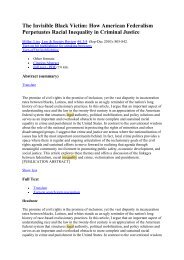Consumer Online Shopping Attitudes and Behavior: An ... - E-Journal
Consumer Online Shopping Attitudes and Behavior: An ... - E-Journal
Consumer Online Shopping Attitudes and Behavior: An ... - E-Journal
Create successful ePaper yourself
Turn your PDF publications into a flip-book with our unique Google optimized e-Paper software.
Electronic Commerce Customer Relationship Management<br />
<strong>Consumer</strong> Satisfaction<br />
<strong>Consumer</strong> satisfaction is the focus of the investigation in only three articles. It can be defined as the extent to which consumers’<br />
perceptions of the online shopping experience confirm their expectations. Most consumers form expectations of the product,<br />
vendor, service, <strong>and</strong> quality of the website that they patronize before engaging in online shopping activities. These expectations<br />
influence their attitudes <strong>and</strong> intentions to shop at a certain Internet store, <strong>and</strong> consequently their decision-making processes <strong>and</strong><br />
purchasing behavior. If expectations are met, customers achieve a high degree of satisfaction, which influences their online<br />
shopping attitudes, intentions, decisions, <strong>and</strong> purchasing activity positively. In contrast, dissatisfaction is negatively associated<br />
with these four variables (Ho <strong>and</strong> Wu 1999; Jahng et al. 2001; Kim et al. 2001).<br />
Implications <strong>and</strong> Recommendations for Future Research<br />
As Table 1 indicates, three out of the five dependent variables (consumer attitudes, intentions, <strong>and</strong> purchasing behavior) <strong>and</strong> three<br />
out of the five independent variables (personal characteristics, vendor/service/product characteristics, website quality) receive<br />
the most attention. This seems to constitute the main stream of research in this area. Twenty-two studies examine the relationship<br />
between consumers’ attitudes towards online shopping <strong>and</strong> other factors, thirteen measure intention to shop online, <strong>and</strong> 14<br />
investigate the connection between online purchasing <strong>and</strong> other factors. Fourteen studies consider personal characteristics, 16<br />
vender/service/product characteristics, <strong>and</strong> 20 website quality. It is found that personal characteristics, vender/service/product<br />
characteristics, <strong>and</strong> website quality significantly affect online shopping attitudes, intention, <strong>and</strong> behavior. The direct implication<br />
of these findings is that targeting more appropriate consumer groups, improving product <strong>and</strong>/or service quality, <strong>and</strong> improving<br />
website quality can positively influence consumer attitudes <strong>and</strong> behavior, potentially leading to increased frequency of initial<br />
purchase <strong>and</strong> repeat purchases on the part of consumers.<br />
The role of the external environment, demographics, online shopping decision making, <strong>and</strong> consumer satisfaction are less well<br />
represented in the IS literature. As is shown in Figure 1, consumers’ satisfaction is a key factor in online shopping, yet only three<br />
studies investigate it. <strong>An</strong>y number of factors, including vender/service/product characteristics, website quality, attitude towards<br />
online shopping, intention to online shopping, online shopping decision making, <strong>and</strong> online purchasing, may influence consumers<br />
satisfaction. More importantly, the extent to which customers are satisfied is directly related to attitudes toward online shopping<br />
or toward specific Internet stores. The relative importance of this factor in determining such consumer behavior as repeat<br />
purchases suggests that further research on consumer satisfaction with online shopping needs to be conducted.<br />
The ten factors <strong>and</strong> the diverse measures used by different studies indicate that online shopping is a multidimensional <strong>and</strong><br />
multidisciplinary phenomenon. Our examination shows that different studies have different ways of operationalizing seemingly<br />
the same constructs. This methodological issue needs to be addressed in future research so that a validated instrument can be<br />
developed for measuring consumer online shopping attitudes <strong>and</strong> behavior.<br />
There is also no consensus on the theoretical models employed to describe <strong>and</strong> predict online shopping attitudes <strong>and</strong> behavior.<br />
This lack of a common theoretical framework suggests the need to develop an integrative model of the phenomenon in order to<br />
promote systematic investigation of its components <strong>and</strong> the online shopping process. By identifying common elements <strong>and</strong><br />
developing our model based on IS literature, we hope to have taken a step toward promoting this type of integration <strong>and</strong> synthesis<br />
of relevant literature across disciplines.<br />
One of the limitations of this study is the selection of the existing studies. Owing to time limitation, we only searched a number<br />
of IS journals <strong>and</strong> conference proceedings. This may leave some other prominent IS empirical studies out. In addition, owing to<br />
the multidisciplinary nature of online shopping, it would be very interesting to compare IS literature to other disciplines that study<br />
online shopping attitudes <strong>and</strong> behavior. These limitations will be addressed in our future studies.<br />
By summarizing the current studies based on IS literature review <strong>and</strong> analysis, this paper identifies ten factors in the area of online<br />
shopping <strong>and</strong> proposes a model describing <strong>and</strong> predicting the relationships among these factors. It provides a comprehensive<br />
picture of the status of this area. This model needs to be validated either theoretically or empirically in future studies.<br />
514 2002 — Eighth Americas Conference on Information Systems














